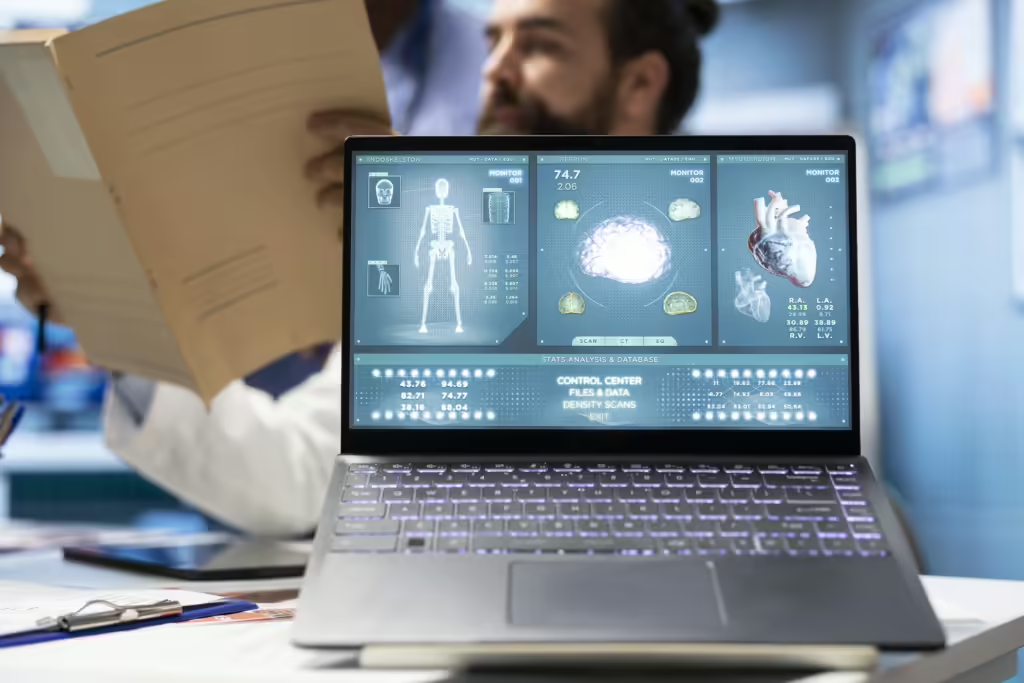Design-Driven HealthTech Trends 2025: Revolutionizing Healthcare Through Thoughtful Design

How’s Healthtech poised to evolve in 2025?
The intersection of healthcare and design has never been more critical. As we approach 2025, the HealthTech industry is experiencing a paradigm shift powered by design thinking. No longer is healthcare just about clinical precision; it’s about creating human-centered, accessible, and impactful experiences—a transformation that is redefining the sector. Let’s dive into the key HealthTech design trends for 2025 and explore how they’re shaping the future.
1. Hyper-Personalized Interfaces
Gone are the days of generic health dashboards. 2025 will see the rise of interfaces tailored to individual needs, conditions, and accessibility requirements. Picture a health platform that adapts in real-time: color-coded alerts for medication, simplified navigation for seniors, or AI-driven insights delivered in plain, jargon-free language.
Why It Matters: Studies show that 60% of patients are more likely to use health platforms that offer personalized experiences. For example, Mayo Clinic’s health app has reported increased adherence to treatment plans through personalized dashboards, resulting in better patient outcomes.
Design Insight: Personalization is not just a feature—it’s a necessity. Future-forward personalization can leverage predictive analytics and AI-driven emotional intelligence to anticipate user needs in real-time. By integrating these technologies, interfaces will feel intuitive and dynamically adapt to user states, creating a deeper sense of connection and empowerment.

2. Experience-First Biowearables
HealthTech wearables are becoming more than medical tools; they’re evolving into lifestyle companions. In 2025, expect adhesive biosensors that resemble tattoos or hydration-monitoring rings that blend seamlessly with daily accessories.
Why It Matters: Biowearable adoption has grown by 25% annually, with designs like the Oura Ring and Fitbit Luxe integrating health monitoring into sleek, fashionable designs. This combination of utility and style ensures higher adoption rates and user satisfaction.
Example: WHOOP’s wearable not only tracks performance but provides recovery insights tailored to athletes, blending data with meaningful, actionable advice.
Design Insight: Designers will balance technology and style by incorporating sustainable materials and exploring integrations with augmented reality (AR) to enhance user experiences. For instance, AR-enabled wearables could provide live health data overlays, blending aesthetics with functionality.
3. Synthetic Biology Meets Speculative Design
The realm of synthetic biology—from gene editing to living medicines—demands a leap in speculative design. Designers will visualize complex processes, such as the functions of synthetic microbes, to bridge the gap between groundbreaking science and everyday understanding.
Why It Matters: Synthetic biology markets are projected to reach $20 billion by 2025. Platforms like the MIT Media Lab and synthetic biology startups like Ginkgo Bioworks have shown how design can demystify complex science, leading to broader acceptance and investment.
Example: A speculative design project visualized how CRISPR-edited crops could integrate into our daily lives, simplifying the concept for non-specialists.
Design Insight: Immersive storytelling and futuristic concepts could be enhanced by involving users in co-creation workshops. This collaborative approach helps visualize and refine speculative applications, ensuring solutions are both innovative and grounded in real-world feasibility.
4. Empathy-Driven Digital Psychedelics
Mental health treatments are entering a new dimension with digital psychedelics. By leveraging virtual reality, soundscapes, and immersive sensory design, these tools aim to help individuals with PTSD, anxiety, or depression achieve therapeutic breakthroughs in safe environments.
Why It Matters: Mental health app revenue has grown by 30% year-on-year, with VR tools like Mindful Powers and apps like Trip demonstrating how immersive experiences can complement traditional therapy methods. Studies suggest a 45% increase in session efficacy with such tools.
Example: PsyTech’s VR environments for PTSD therapy use calming colors, guided soundscapes, and safe virtual spaces to replicate effective psychedelic-assisted therapy experiences.
Design Insight: Designers will incorporate calming visuals and adaptive interfaces using biometrics to create hyper-personalized therapy experiences. VR environments could adjust in real-time to users’ stress levels, offering tailored pathways to emotional well-being.

5. Organ-on-a-Chip Visualizations
One of the most fascinating advancements, organ-on-a-chip technology, replicates human organ functions on microchips. However, its complexity demands visual clarity. Designers will develop simulations and animations to simplify this innovation for healthcare stakeholders.
Why It Matters: Organ-on-a-chip technology is predicted to reduce drug testing costs by 30%, with platforms like Emulate Inc. already leveraging visual simulations to explain their functionality to investors and researchers.
Example: Visualizing how a lung-on-a-chip works has helped researchers convey its potential to replace animal testing, encouraging faster adoption in pharma.
Design Insight: Visual communication will evolve to include interactive 3D models and VR simulations, allowing stakeholders to ‘step inside’ the organ-on-a-chip systems. This immersive approach can transform comprehension and foster broader adoption across industries.
6. Quantum-Enhanced Health Experiences
Quantum computing promises to unlock vast healthcare datasets. The challenge lies in translating these insights into actionable solutions. By creating intuitive data visualizations and workflows, designers will empower healthcare providers to harness quantum-powered analytics effectively.
Why It Matters: By 2025, quantum computing in healthcare is expected to reach $2 billion. Innovations like quantum-powered diagnostics have already demonstrated their ability to process massive datasets, reducing diagnostic times by 50%.
Example: IBM’s Quantum Health initiative has shown how quantum computing can analyze genetic data to identify disease patterns faster.
Design Insight: Quantum-powered tools can benefit from gamification elements, transforming raw data into engaging, goal-oriented challenges for healthcare providers. This approach could incentivize quicker decision-making and deeper exploration of quantum insights.

7. Ambient Health Systems
Imagine a future where homes and workplaces seamlessly monitor health without being intrusive. Ambient health systems will utilize sensors integrated into furniture or mirrors to detect anomalies and provide subtle, actionable alerts.
Why It Matters: By 2025, 70% of smart home devices will include health-monitoring features. Examples like Google’s Nest and Samsung’s health-monitoring refrigerators show the potential of unobtrusive care systems in improving early detection of health issues.
Example: A mirror with embedded sensors could monitor skin health for early signs of melanoma, alerting users to seek medical advice.
Design Insight: Privacy and usability will be reimagined through emotional AI integrations in ambient health systems. These technologies could proactively detect emotional states and recommend interventions, offering holistic support beyond physical health.
8. mRNA Therapies and Visual Storytelling
The evolution of mRNA technology beyond vaccines is set to revolutionize healthcare. But its complexity can intimidate patients. Designers will craft engaging educational tools and animations that break down these therapies, fostering understanding and trust.
Why It Matters: mRNA technology is now expanding to personalized cancer treatments and therapies for rare genetic disorders. Companies like Moderna emphasize clear communication to combat misinformation and increase acceptance.
Example: Animated explainer videos on how mRNA works have led to a 60% increase in patient understanding and reduced vaccine hesitancy during COVID-19.
Design Insight: Simplified storytelling will leverage voice-assistive technologies and interactive narratives to demystify complex mRNA therapies. By incorporating patient feedback loops, these tools can dynamically address concerns, boosting trust and engagement.

9. Neurohacking UX: Designing for the Mind
Brain-computer interfaces (BCIs) are redefining neural stimulation therapies. From interfaces that adjust brainwave modulation to personalized cognitive recommendations, intuitive UX design will be crucial.
Why It Matters: The BCI market is expected to reach $3.85 billion by 2025. Neurotech companies like Neuralink emphasize user-centric design to ensure accessibility for non-technical users.
Example: A headband that provides real-time feedback on stress levels, designed with a user-friendly mobile interface, has improved compliance in cognitive therapies by 35%.
Design Insight: Designers will explore neurofeedback loops to create dynamic BCI interfaces that adapt based on user brain activity. These systems could enable real-time adjustments in therapy, unlocking new potential for cognitive and neurological treatments.
10. Decentralized Clinical Trials
With clinical trials moving to digital and decentralized platforms, design thinking will put patients at the center. Accessible mobile apps for data collection and culturally relevant materials for diverse populations will ensure trials are inclusive and effective.
Why It Matters: Decentralized trials can reduce recruitment time by 30% and increase participation diversity by 40%. Apps like Medable showcase how intuitive design improves user engagement and reliability.
Example: A trial app offering multilingual support and user-friendly navigation increased participation rates in underrepresented communities by 25%.
Design Insight: Accessibility and empathy will be enhanced by AI-driven localization and culturally adaptive designs for decentralized trials. This approach ensures inclusivity by addressing linguistic and cultural nuances across diverse patient demographics.
Why Design Thinking Matters in HealthTech

At its core, design thinking is about empathy, ideation, and problem-solving—qualities that align perfectly with the demands of modern healthcare. From creating intuitive health journeys to fostering trust in groundbreaking technologies, design is transforming how care is delivered and experienced.
As we look toward 2025, one thing is clear: the future of HealthTech lies in design. By focusing on user-centricity, inclusivity, and innovation, we can build healthcare solutions that are not just functional but transformative.
Let’s design for a healthier, more connected world—one interface, wearable, and experience at a time.



